
What makes an effective hybrid workplace?
Reading time: about 10 min
Before the pandemic, the idea of a nationwide remote workforce was practically unthinkable in corporate America. Today, it’s estimated that 1 in 4 Americans work at home at least half the time, making the hybrid workplace in the United States roughly 39 million strong and counting.
As more people head back to the office, establishing clear guidelines for your hybrid culture is critical. Will your organization take a remote-first approach for its hybrid workplace? Is having a physical presence at work optional? Or will your hybrid workplace require specific in-office days?
Whichever hybrid office approach your business takes will be influenced by the employees that comprise its hybrid workplace. But how effective your hybrid culture will depend on leadership.
To illustrate this point, let’s consider the story of two fictional companies, ABC Technology and XYZ Industries and how they respond to five decisions you may come across in your hybrid workplace.
Expectations and guidelines
Before the pandemic, the only remote employees working at ABC Software were the contractors and freelancers it hired to help on massive projects with quick turnarounds or to fulfill RFPs for big potential clients. Given their positive experience with working from home, they’ve adopted a hybrid culture.
The leadership team at ABC Software realizes that a hybrid workplace isn’t just about flexibility. For a hybrid workplace to thrive, every employee needs to understand what’s expected of them.
Collaboration and brainstorming are important to this tech firm. Since most of their employees live within a 30-commute of their location, ABC Software’s policy of Mondays and Tuesdays in the office wasn’t an issue. If someone needs to work remotely either of those days, it can be requested.
During the pandemic, ABC hired a handful of full-time employees from out of state. Because they’re involved in more solitary, independent roles, they were allowed to remain 100% remote.
Still, all employees are expected to complete tasks on time, attend required meetings, and stay in contact with their team. Beyond these guidelines, employees are free to set their schedules.
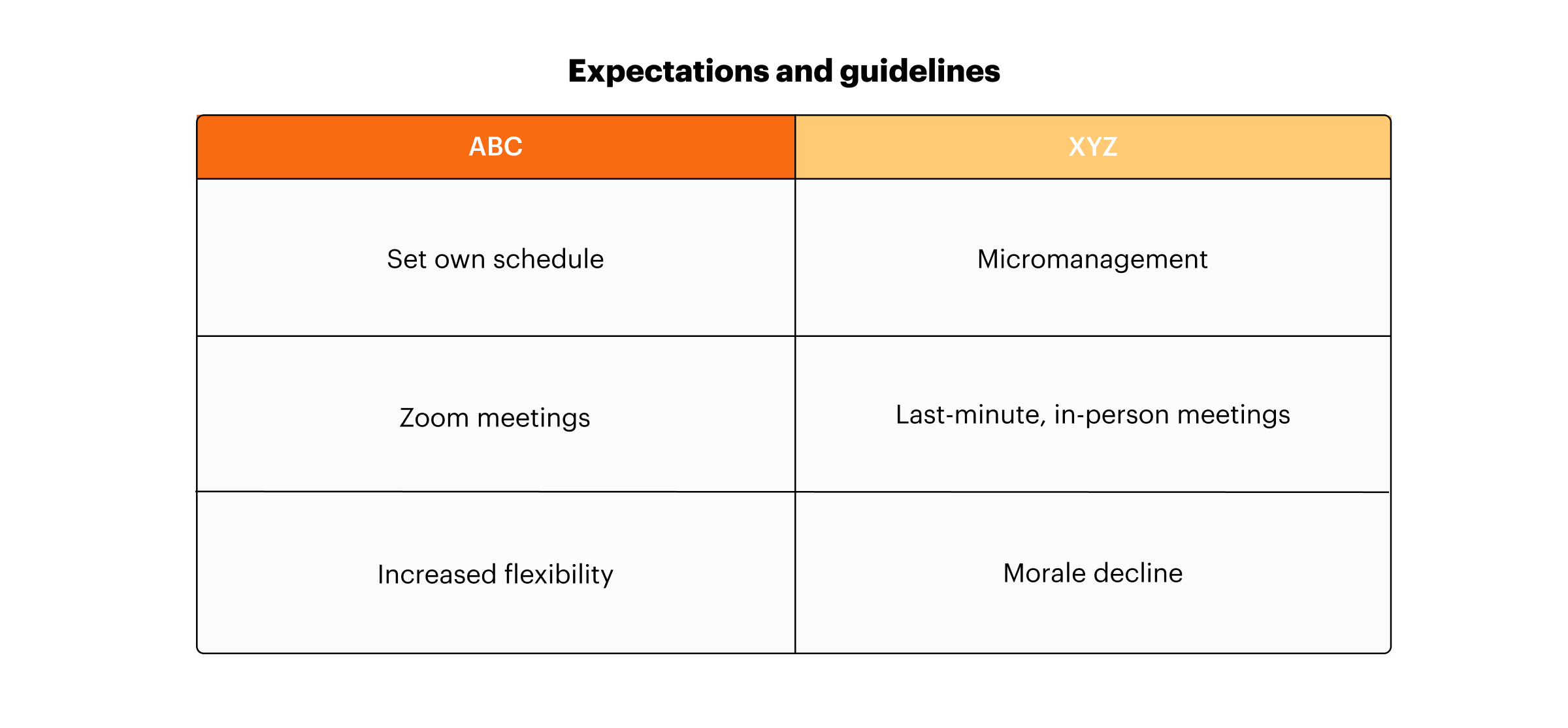
In contrast, the hybrid culture at XYZ Industries is much less defined. Initially, the policy for its hybrid workplace was for everyone to choose “whatever schedule felt most comfortable.” Yet, XYZ managers began to routinely check up on remote workers not online by 8 am or after 6 pm.
This informal policy was puzzling for its remote workforce. Projects were still being completed on time. However, workers who returned to the office were held to less scrutiny, even favored by management. Many meetings seem to be held at the last minute, without a Zoom component.
What was expected in XYZ’s hybrid workplace? If it was crucial to maintain an office presence, why wasn’t that policy formalized by management? Employees who preferred to work from home suddenly felt reluctant to do so. But what days made the most sense to work in the office and at what times?
Not surprisingly, XYZ’s workforce felt frustrated, betrayed, and even angry. Many decided to pursue opportunities elsewhere, and productivity and morale soon declined.
Collaborative software and tools
Given the nature of the projects at ABC Software, communication is a top priority. Teams are interdependent, collaborate often, and in need of real-time updates on project status, scope changes, and more. Fortunately, this is a hybrid office with the tools it needs to stay productive.
Using Slack, ABC’s employees get the benefits of email, text, and instant messaging in one app. Teams discuss specific projects in dedicated channels, even from their phones if they happen to step away from their desks. Some channels are dedicated to fun topics to keep things light.
With Asana at their disposal, everyone gets the help they need to stay on target, keep projects organized, and meet deadlines. For ABC’s hybrid workplace, this tool’s ability to track individual tasks, plan sprints, and visualize progress with its boards allows its teams to not miss a beat.
By leveraging the Lucid Visual Collaboration Suite, employees can diagram, whiteboard, and brainstorm virtually to take plans from sketches all the way to successful delivery. It also makes participation a breeze, regardless of whether teams are working in the office or not.
Giving people access to collaborative tools is the hallmark of any effective hybrid workplace.
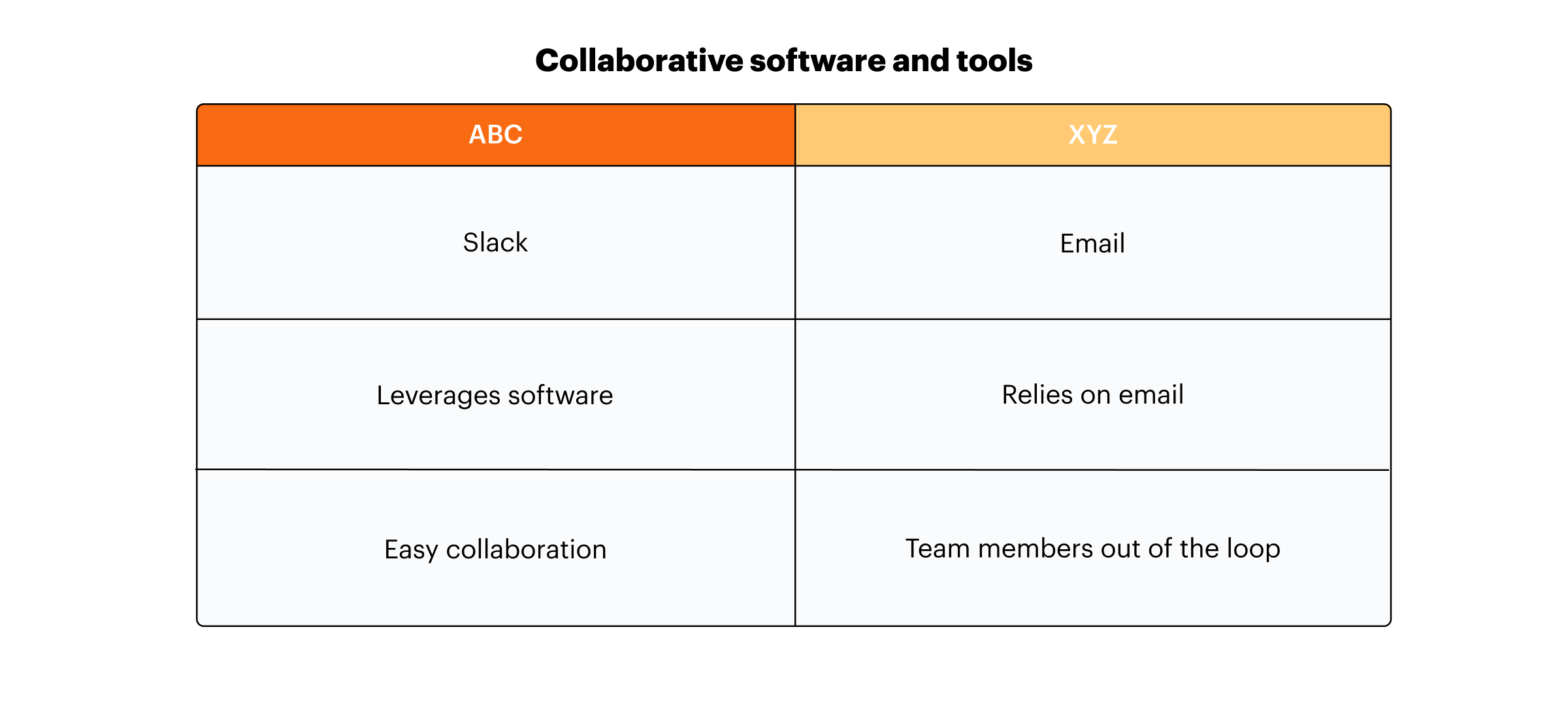
For an ineffective hybrid workplace, like XYZ Industries, the availability of intuitive, collaborative, user-friendly tools isn’t a top priority. XYZ’s leadership figures that if email was good enough for daily office use, why wouldn’t it be for remote work? They never stopped to consider:
- On any given workday, employees can receive 100+ emails
- Many people don’t bother to read their email when it’s too long
- Most emails seem to lack immediacy and are easily overlooked
- Email limits the inclusion of rich media, making it less engaging
Worst of all, for a hybrid culture that demands immediate and constant feedback, email can feel particularly cumbersome. When working remotely, XYZ employees rely on emails as their lifeline to their hybrid workplace. People in the office will tend to ignore email, especially group emails.
In the attempt to tailor messages for entire teams, group emails at XYZ are either too detailed or lack the right amount of specificity for the team members who need the information most. And once too many join in with their “reply all” messages, the point of the conversation is lost.
When team assignments change, subsequent emails go out to the wrong employees. And other times, people accidentally forget to include team members on outgoing emails in the first place.
This confusion could easily be avoided at XYZ by simply providing everyone with the right tools.
Onboarding and training protocols
For any business, the onboarding process plays a critical part in the success and happiness of a new hire. For a hybrid workplace, a positive onboarding experience for remote employees is that much more critical. A forward-thinking business with a hybrid office like ABC Software gets this.
Lately, much of ABC’s onboarding process happens remotely. When competing for top talent, it made good business sense for them to provide new hires with the best possible experience. In those first few weeks of onboarding, ABC put in the extra effort to familiarize people with its hybrid culture and share insights about what it takes to be successful in a hybrid workplace.
New hires at ABC get integrated into the company’s processes and culture through a series of interactive Zoom meetings, including a virtual lunch and trivia challenge. During their first few weeks, employees are assigned a “work buddy” to answer questions and provide mentorship.
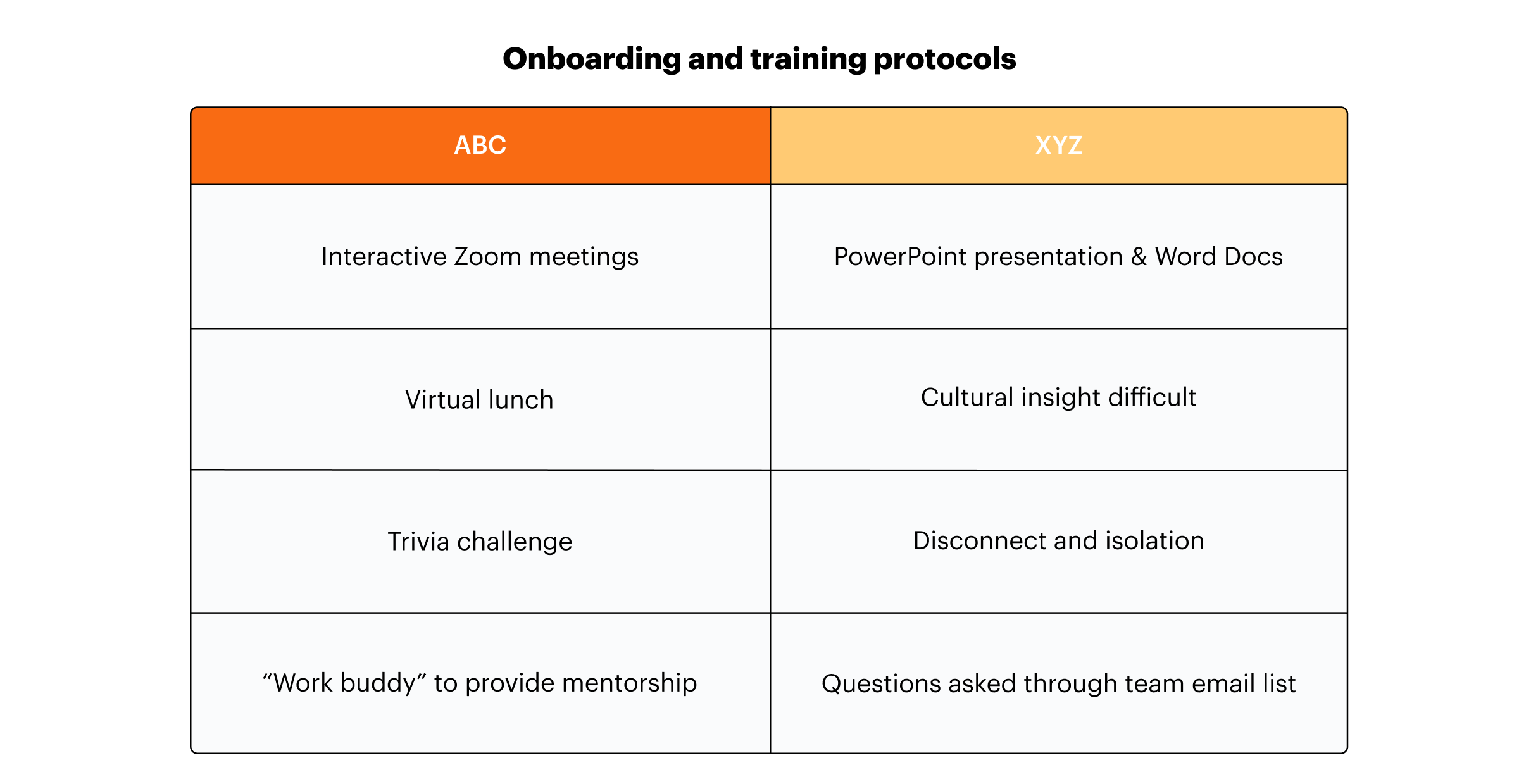
In contrast, XYZ’s onboarding process is mostly self-guided outside of the orientation meeting at the office.
New hires receive a PowerPoint presentation and a series of Word docs in an onboarding group email. The ability to interact or ask questions is limited to email links provided in a team list. It’s difficult for new XYZ employees to gain real-time feedback or true insight into the hybrid culture.
As a result of this one-size-fits-all approach to their onboarding process, new hires at XYZ tend to feel isolated or disconnected from the team. It’s difficult at best for any of them to get a real feel for how well they’re doing or if they even fit in at XYZ during those critical first few weeks.
Onboarding in a hybrid workplace requires extra effort to ensure new hires receive the level of support, interaction, and guidance it takes to thrive, especially if it’s being conducted remotely.
Team alignment and processes
Hybrid workplace or not, it’s important to set an agenda to ensure key objectives are completed and agreed-upon timelines are met. When first making the transition to a hybrid office, leadership at ABC set a clear context for the team to stay aligned and outlined which processes they should follow.
Every day, teams conduct scrum-style check-in meetings for 15 minutes, held in-person or on Zoom (depending on the day of the week). Meeting times vary by team, set to fit everyone’s schedule.
On a regular basis, managers also hold one-on-one meetings with each of their team members.
A good portion of these meetings is used to see how employees are doing on a personal level, talking about interests and pursuits outside of work. Given how transactional it can feel to be in a hybrid office without opportunities for impromptu conversation, this time is important at ABC.
The rest of the meeting time is used as an open forum for employees to discuss their concerns, ideas, and input. ABC recognizes the value of letting everyone speak openly to identify problems and opportunities as a key part of its process to keep teams aligned within its hybrid workplace.
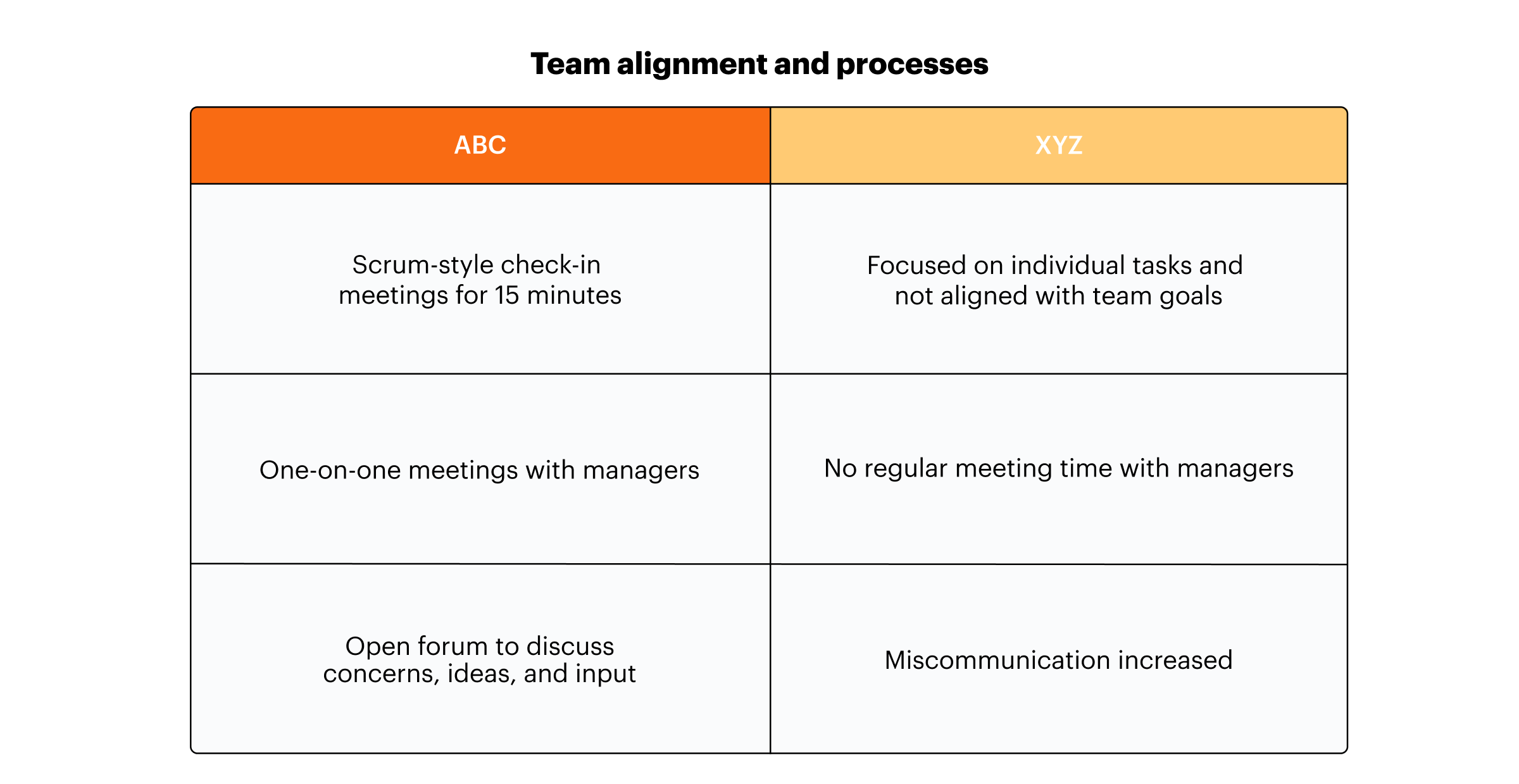
At XYZ, employees often feel left to themselves. “As long as the work gets done” is a common mantra. This hands-off approach seemed fine early on. But after a few weeks, many employees felt solely focused on their individual tasks and not as aligned to their team’s overarching goals.
Without regular check-in meetings with their managers or fellow team members, deadlines that seemed reasonable were often missed. Miscommunication increased. People prioritized tasks based on what made the most sense to them, rather than what was best for the team or project.
But who’s to blame? Responsibility for team alignment and processes always starts at the top.
Culture
Flexibility and work-life balance are what make the hybrid workplace so appealing to employees.
But what about work culture? Culture is a critical aspect to any effective organization. But how can a company create, nurture, or maintain its work culture with less time together in the office? People also want to feel connected to a purpose, as well as a sense of community and support.
At ABC, leaders are intentional when it comes to talking about the big picture, shared purpose, and how everyone’s work contributes to the overall success of the firm. Teams are also reminded of the way roles overlap. All because of how crucial accountability is to culture.
In a hybrid workplace, it’s easy to forget how individual performance affects the business when people aren’t working by each other’s side on a consistent basis. Without a regular presence in the office, there’s less opportunity to know what’s going on, feel visible, or bond with coworkers.
ABC always strives for transparency and accessibility with its employees. Working out of office shouldn’t mean being out of mind in a hybrid office. It’s all about fairness. Without it, people can lose motivation. Which is why ABC makes a point of recognizing the work of remote employees.
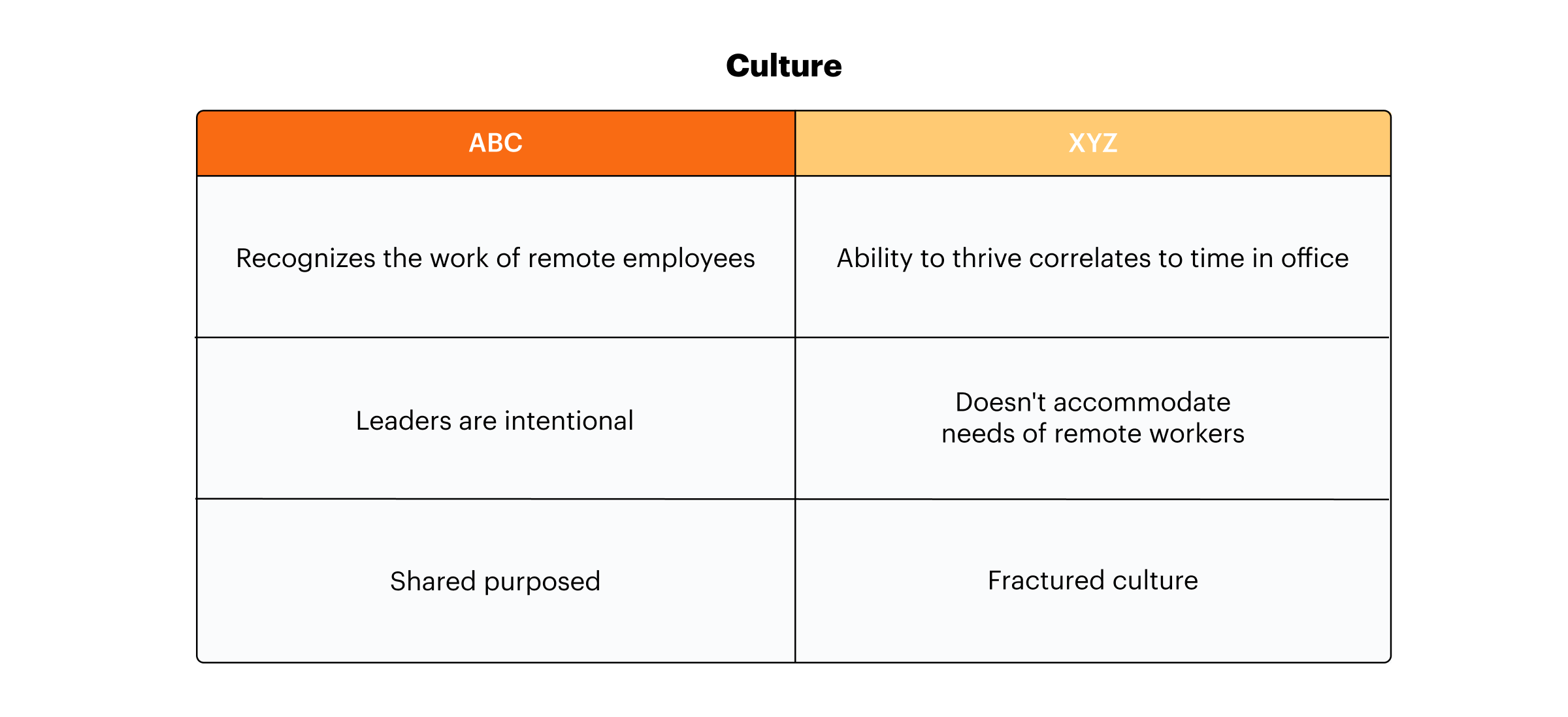
At XYZ, employees who choose to spend more time at the office seem favored over those who work remotely. They enjoy greater access to management and more visibility for the work they do. This has fractured the once strong and unified culture that existed at XYZ before the pandemic.
The message, intended or not, is simple. Although functioning as a hybrid workplace, the ability to thrive in your career at XYZ correlates to how often (or willing) you are to work in the office.
Transforming your business into a hybrid office beyond the pandemic doesn’t stop at ensuring everyone has a work laptop to use at home. It also means adapting the culture to accommodate the needs of the remote workforce.

Want to take a page out of ABC Technology’s book and leverage Lucidchart for your hybrid team?
Learn more hereAbout Lucidchart
Lucidchart, a cloud-based intelligent diagramming application, is a core component of Lucid Software's Visual Collaboration Suite. This intuitive, cloud-based solution empowers teams to collaborate in real-time to build flowcharts, mockups, UML diagrams, customer journey maps, and more. Lucidchart propels teams forward to build the future faster. Lucid is proud to serve top businesses around the world, including customers such as Google, GE, and NBC Universal, and 99% of the Fortune 500. Lucid partners with industry leaders, including Google, Atlassian, and Microsoft. Since its founding, Lucid has received numerous awards for its products, business, and workplace culture. For more information, visit lucidchart.com.
